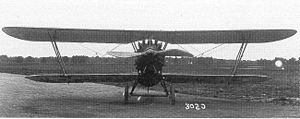Bristol Badger
| Badger | |
|---|---|
 |
|
| Role | Fighter-reconnaissance |
| National origin | United Kingdom |
| Manufacturer | The Brititsh & Colonial Aeroplane Co. Ltd |
| Designer | Frank Barnwell |
| First flight | 4 February 1919 |
| Number built | 5 |
The Bristol Badger was designed to meet a British need for a two-seat fighter-reconnaissance aeroplane at the end of World War I. Despite the 1918 Armistice, three Badgers were delivered to the Air Board to develop air-cooled radial engines, particularly that which became the Bristol Jupiter; two other Badgers were also built.
The Bristol Badger had its roots in the Type 22 F.2C, a proposed upgrade of the Bristol F.2B using a 200 hp (150 kW) Salmson radial (Type 22), a 300 hp (220 kW) ABC Dragonfly radial (Type 22A), or a 230 hp (170 kW) Bentley B.R.2 rotary (Type 22B). The Type 23 Badger was a new design using the Dragonfly engine, drawn up at the end of 1917 to meet a two-seat fighter-reconnaissance role and owing a good deal to the Bristol Scout F. It was a single-bay biplane with strongly staggered, unswept and unequal-span wings. The pilot and observed sat in tandem, the pilot in front under the upper-wing trailing edge and the observer behind with a ring-mounted 0.303 in (7.7 mm) Lewis Gun. At first, the Badger carried almost no fixed fin. Construction was the traditional wood-and-fabric of the time and the undercarriage was a single axle plus tailskid arrangement.
During the design process, it became clear that the Dragonfly engine, was proving unreliable and Bristol looked to a new nine-cylinder, 400 hp (300 kW) radial produced by Brazil Straker and known then as the Cosmos Jupiter as a possible alternative. Later, this engine became the Bristol Jupiter.
Bristol was awarded a contract to build three Badgers, two powered by the Dragonfly and one (the second) by a Jupiter. The first Badger flew on 4 February 1919 but crashed on this first flight with fuel supply problems. It was rebuilt with a larger rudder and delivered to the Air Board eleven days later. The second, Jupiter-engined Badger, flew on 24 May but was re-engined with a Dragonfly and was purchased by the Air Board in September. It had full armament and a fixed, rounded fin, introduced to cope with the heavier Jupiter engine. The Badger proved to have a lateral stability problem, an adverse yaw effect caused by aileron drag, and because of this, the third machine was not accepted by the Air Board. These first three machines were designated Badger I.
...
Wikipedia
